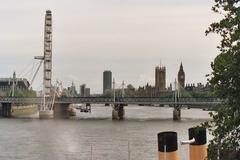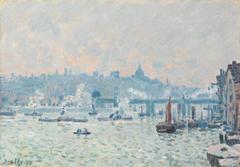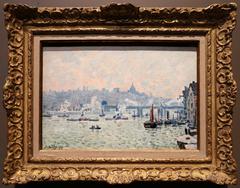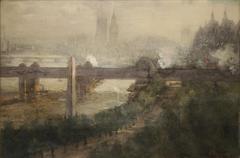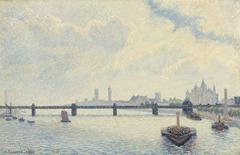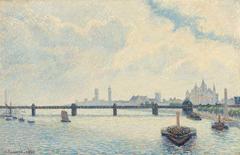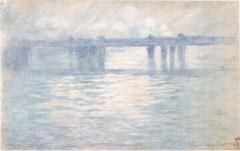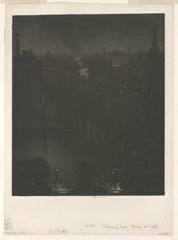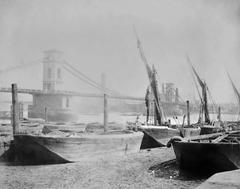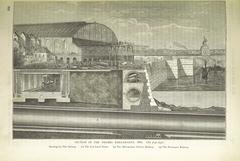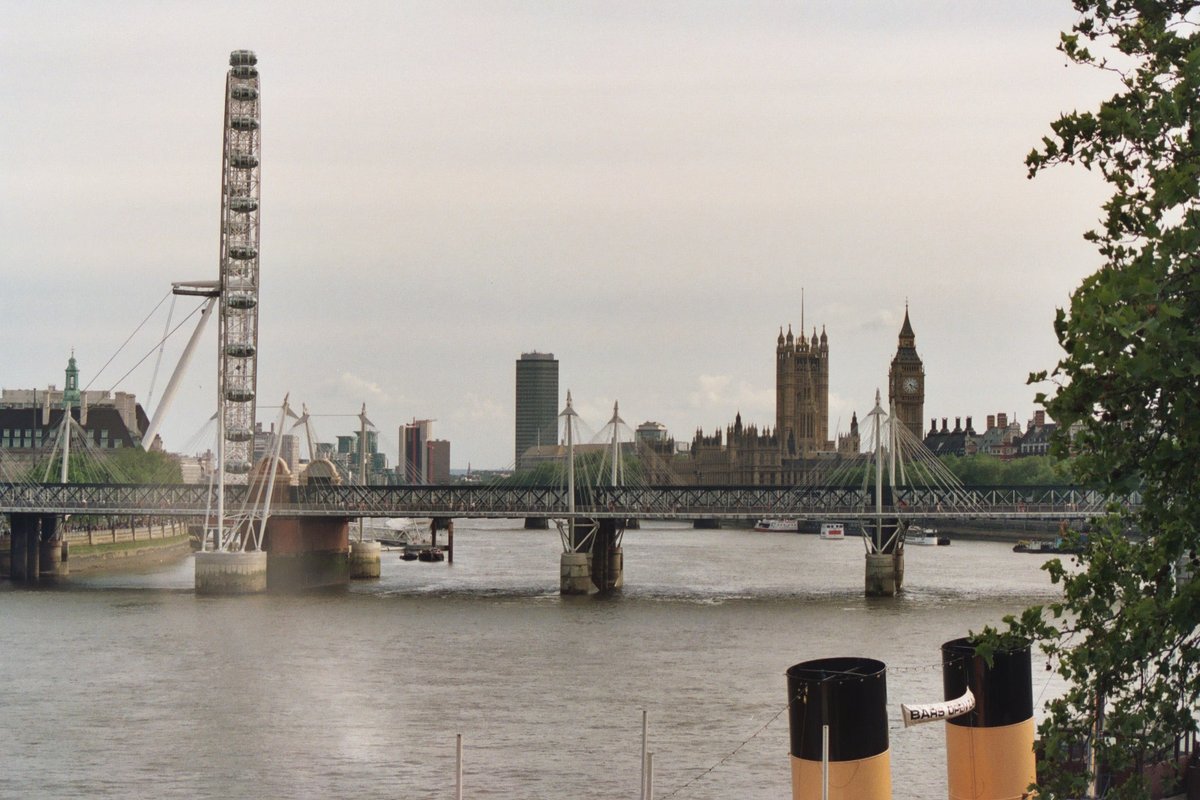
Hungerford Bridge and Golden Jubilee Bridges: Visiting Hours, Tickets, and Travel Guide
Date: 14/06/2025
Introduction
The Hungerford Bridge and Golden Jubilee Bridges are not only functional crossings over the River Thames, but also stand as enduring symbols of London’s innovation, history, and urban vitality. Connecting Charing Cross and the historic North Bank with the cultural South Bank, these bridges are celebrated for their engineering, accessibility, and breathtaking panoramic views. Whether you are a history enthusiast, architecture lover, or a traveler seeking memorable river walks, this guide provides everything you need to know—including history, visiting tips, accessibility, and nearby attractions.
Table of Contents
- Introduction
- Historical Overview
- Architectural Evolution
- Visitor Information
- Cultural and Urban Significance
- Nearby Attractions and Photo Spots
- Events and Everyday Life
- Visitor FAQs
- Summary and Travel Tips
- References
Historical Overview
Brunel’s Suspension Footbridge (1845)
In the mid-19th century, as London expanded rapidly, the Hungerford Market Company commissioned Isambard Kingdom Brunel to design a pedestrian suspension bridge to draw visitors to the market. Opened in 1845, this pioneering structure spanned 1,462 feet (446 meters), making it the longest suspension bridge in Britain at the time. Its wrought iron chains and graceful profile established it as an engineering marvel and a landmark for Londoners (Google Arts & Culture).
Transformation to Railway Bridge (1864)
With the advent of the railway age, London’s priorities shifted toward mass transit. In 1864, Brunel’s footbridge was dismantled, its chains repurposed for the Clifton Suspension Bridge in Bristol. The new Hungerford Railway Bridge, designed by Sir John Hawkshaw, opened that same year, providing a vital rail link from Charing Cross to the south of the Thames. The utilitarian design reflected the industrial era’s focus on durability and capacity (Tootbus).
Architectural Evolution
Modernization and the Need for Pedestrian Access
For decades, the railway bridge included only a narrow, exposed pedestrian path. As the South Bank developed into a vibrant arts district in the late 20th century, the need for safer, more accessible pedestrian crossings became urgent. The old walkway was criticized for being uncomfortable and unsafe, especially after dark (alondoninheritance.com).
The Golden Jubilee Footbridges: Design and Construction (1996–2003)
In 1996, an international competition led to the selection of Lifschutz Davidson Sandilands and WSP Group to design twin pedestrian bridges flanking the railway. These cable-stayed bridges, each 320 meters long and over 4 meters wide, feature inclined pylons and a web of suspension cables, creating a modern silhouette against the city skyline. Opened in 2003 to mark Queen Elizabeth II’s Golden Jubilee, the bridges offer step-free access and have become among London’s busiest pedestrian routes (Illuminated River; London Blog).
The construction was a significant engineering achievement, requiring the maintenance of rail operations and the protection of underground lines. These bridges not only improved safety and accessibility but also provided dramatic views and a new aesthetic harmony along the Thames (Square Mile Health Walks).
Visitor Information
Hours and Tickets
- Open 24/7: The bridges are public thoroughfares accessible at any time, day or night.
- Free Entry: No tickets or fees are required to cross the bridges (Komoot; Local London).
Accessibility
- Step-Free Access: Lifts and ramps at both ends accommodate wheelchairs, strollers, and those with mobility needs.
- Tactile Paving: Designed for visually impaired visitors.
- Wide Walkways: Easily support heavy foot traffic and allow for comfortable passage.
Getting There
- North Side: Charing Cross and Embankment stations (Underground and National Rail).
- South Side: Waterloo Station (Underground and mainline rail).
- Buses and Riverboats: Multiple bus routes and river services stop nearby.
Cultural and Urban Significance
The Hungerford and Golden Jubilee Bridges are more than just functional crossings. They symbolize London’s commitment to connectivity, inclusivity, and urban renewal. The bridges link the historical heart of Westminster with the dynamic South Bank arts scene, playing a vital role in the area’s regeneration and economic growth (easymalc.co.uk; alondoninheritance.com).
The Golden Jubilee Bridges’ cable-stayed design and nighttime illumination by artist Leo Villareal (as part of the Illuminated River project) have earned them recognition for both engineering excellence and artistic contribution (Illuminated River).
Nearby Attractions and Photographic Spots
From the bridges, visitors are treated to panoramic views of:
- The London Eye
- Houses of Parliament and Big Ben
- St. Paul’s Cathedral
- Royal Festival Hall and Southbank Centre
- Trafalgar Square and the West End
The bridges are ideal for sunrise and sunset photography, with the north walkway offering the best views of Westminster and the London Eye, and the south side overlooking the City skyline (Komoot).
Within a short walk, you’ll find:
- London Eye (10 minutes)
- Trafalgar Square (10 minutes)
- Southbank Centre and Royal Festival Hall (adjacent)
- National Gallery (near Trafalgar Square)
Events and Everyday Life
The bridges are central to London’s cultural life, serving as vantage points for events like New Year’s Eve fireworks and the Thames Festival. Street performers, musicians, and artists animate the walkways, while regular commuters and tourists alike make the bridges some of the busiest pedestrian crossings in London (easymalc.co.uk).
Visitor FAQs
Are there tickets or fees to visit?
No, both bridges are public and free to access 24/7.
Are they wheelchair accessible?
Yes, lifts and ramps are available at both ends.
Can I take photos?
Absolutely—these are some of the best photo spots in London.
Can I cycle across?
Cyclists must dismount and walk across the pedestrian bridges.
Are there restrooms nearby?
Yes, at Charing Cross, Embankment, and the Southbank Centre.
Are guided tours available?
Many South Bank and Westminster walking tours include the bridges.
What’s the best time to visit?
Daytime for clear views; evening for illuminated cityscapes.
Summary and Travel Tips
The Hungerford Bridge and Golden Jubilee Footbridges exemplify London’s blend of historic heritage and modern innovation. With step-free access, 24/7 free entry, and connections to major attractions, these bridges are unmissable for visitors and locals alike. Whether you’re seeking panoramic cityscapes, a scenic walk, or a link between London’s cultural quarters, these bridges deliver a quintessential London experience.
Visitor Tips:
- Wear comfortable shoes for walking.
- Visit at sunrise or sunset for the best views and photos.
- Use public transport to avoid congestion.
- Take time to enjoy the street performances and riverside atmosphere.
- Download the Audiala app for guided tours and insider tips.
References
For more on London’s bridges, riverside walks, and cultural attractions, download the Audiala app and follow us on social media for the latest updates, travel tips, and guided tour options. Make your London adventure unforgettable by exploring the sights, stories, and experiences that make the Hungerford and Golden Jubilee Bridges truly special.
